
Occasionally, somebody asks me that ridiculous question: “What’s your favorite tree?” As if I could choose just one. If pushed to decide, however, I usually find myself saying, “Sassafras.”
Sassafras albidum is native from Massachusetts and Michigan in the north to the eastern edge of Oklahoma in the west and to North Florida in the south.
It flourishes in the Cincinnati area, which is where it seduced me with its many charms. The spicy-scented foliage, variously shaped like ovals, mittens, or three-toed dinosaur tracks—sometimes all on the same branch—is certainly one of its endearing qualities.
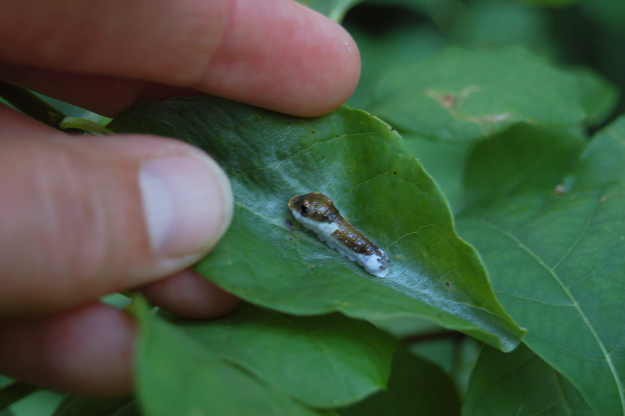
Folded up in a leaf you may find the caterpillar of a beautiful spicebush swallowtail butterfly (if you’re in the East), which readily uses sassafras as an alternate host plant in place of spicebush (Lindera benzoin).
Some showy moths also lay their eggs on sassafras, including the majestic giant prometheus moth.
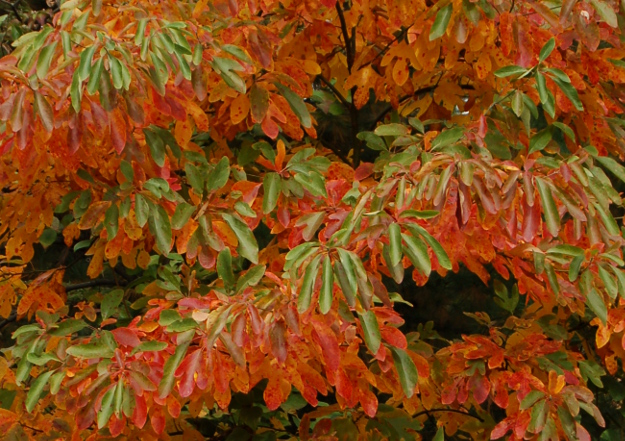
Sassafras is one of the first trees to begin to turn color in the fall, with some plants showing glimmers of orange or pink-red as early as mid-September in the Ohio Valley. Color peaks around the third week of October there.
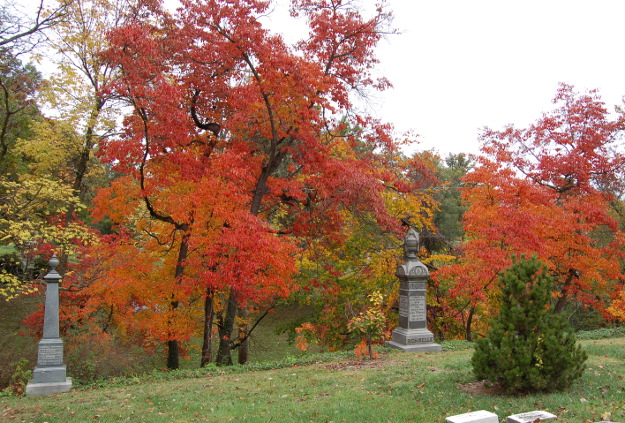
Several swoon-worthy sassafras trees dot the grounds at Spring Grove Cemetery and Arboretum in Cincinnati.
I have to say, it makes my heart ache to look at some of these photos. For while I have no regrets about moving to Portland some three and a half years ago, and heaven knows the Pacific Northwest certainly has more than its fair share of horticultural wonders, it pains me to see these dear old friends that I left behind.
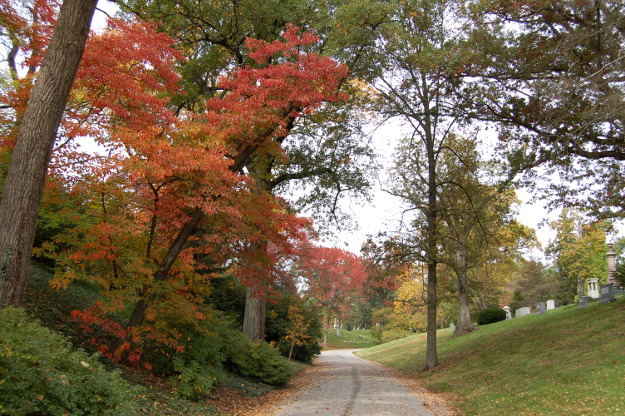
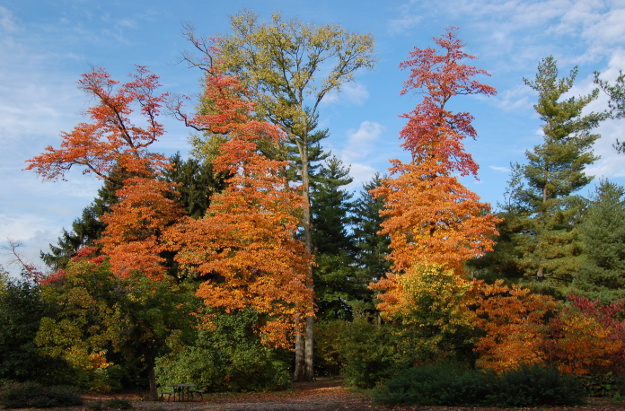
I miss them still.
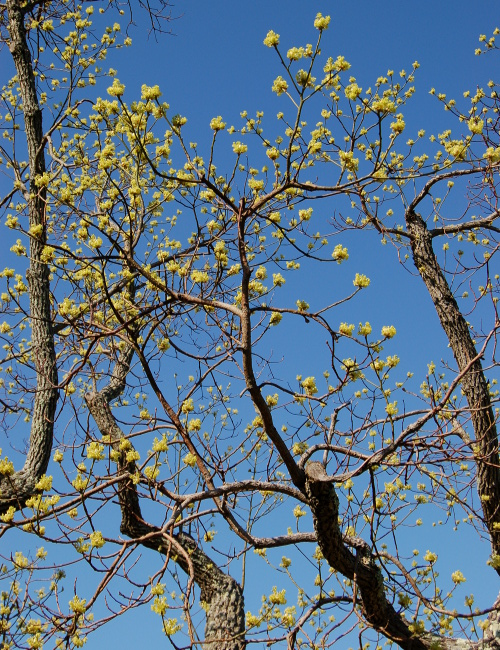
But I digress. Sassafras erupts in tiny chartreuse-yellow blooms in spring before the leaves come out, at the same time as lilacs and crabapples are beginning to flower. Sassafras is usually dioecious, which means that male flowers and female flowers appear on separate plants.
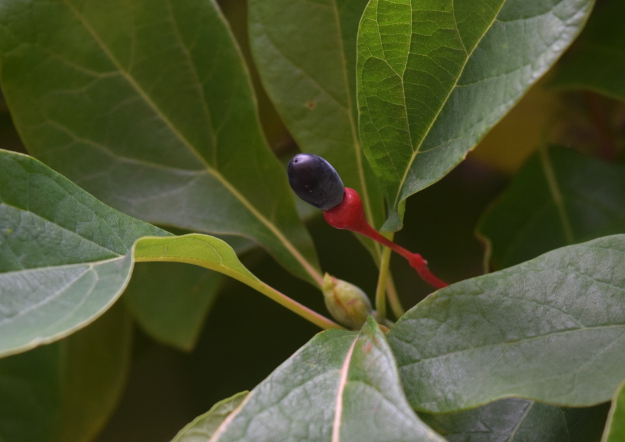
Female flowers morph into deep blue fruits on red pedicels. The fruits attract songbirds such as bluebirds to feast.
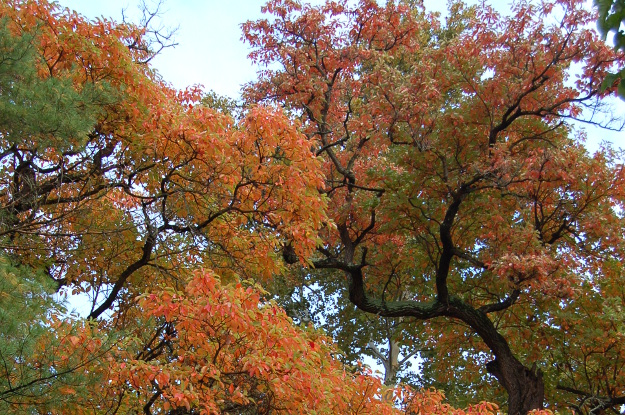
One of my favorite things about sassafras is its contorted branching pattern. This is called sympodial branching—the apical meristem (terminal bud) of a branch will sometimes stop growing, and a lateral bud will take over, changing the direction of growth. When this happens over and over again, it creates a distinctive, craggy silhouette. Flowering dogwoods have a sympodial branching habit, too.

The bark is fantastic as well. In time, it develops deeply furrowed, criss-crossed patterns.

A charismatic old specimen at Stanley Rowe Arboretum in Cincinnati shows the rugged texture of the bark that comes with age.

Sassafras may send up suckers, especially if its main trunk is damaged, and it may eventually form a thicket. Attempts to transplant suckers usually fail, as each clone is dependent upon the mother plant and has few roots of its own. Container-grown seedlings do very well, however, and grow quickly.
According to Donald Peattie in A Natural History of North American Trees (a must-have if you love native trees), a tonic made from fragrant sassafras roots was once believed to be a cure for all sorts of ailments, from malaria to “griefes of the head.” In the late 1500s and early 1600s, the roots were an important early export from the American Colonies.
More recently, root extracts have been used to flavor root beer and candy, but in the 1970s, the FDA declared them mildly carcinogenic, and that put an end to that. Sassafras leaves, though, contain hardly any of the carcinogenic substance (saffrole), and today the powdered thickener knows as filé that goes into an authentic pot of Creole jumbo is still derived from crushed sassafras leaves.
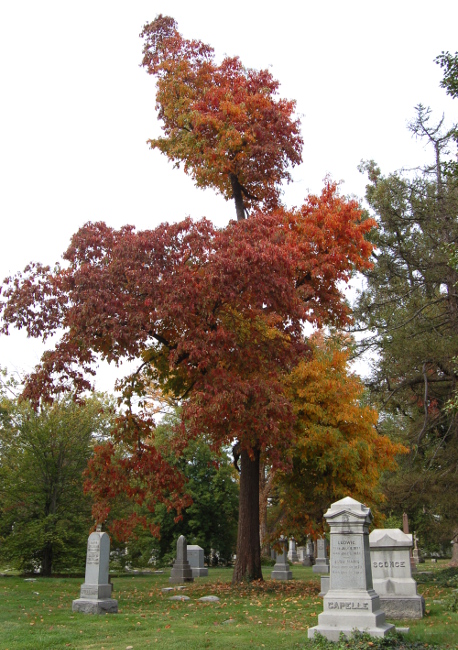
Sassafras will grow as a single-trunked tree if suckers are eliminated.
The largest sassafras tree in the world is in Owensboro, Kentucky, about 200 miles from Cincinnati. I never made the three-hour-plus drive to visit it, but it’s reportedly over 100 feet tall, with a trunk 7 feet thick.
In Native Trees for North American Landscapes (a must-have if you’re into native trees of the eastern states), Guy Sternberg tells the story of the champion tree’s near-demise. In 1957, the state highway department had the tree slated for destruction in order to widen a road, but the lady of the house on whose property the tree grew had other ideas. She emerged with a loaded shotgun, and after a long standoff, the state backed down.
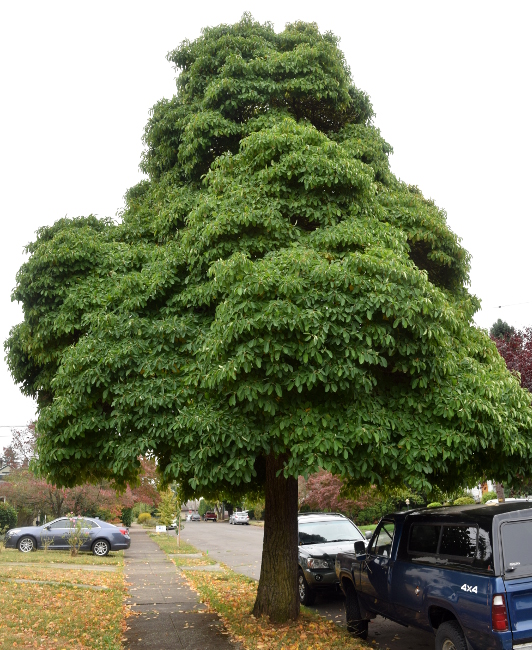
I have found a couple of sassafras trees here in Portland, Oregon. I noticed one at the Leach Botanical Garden, and this one on 73rd Ave. in the Montavilla neighborhood gives me faith that this tree can excel here. I’m thinking about planting a sassafras on my own property, but I don’t want to irrigate much, and our dry, dry summers give me pause.

Strangely enough, the Montavilla tree’s foliage is all ovals—there are no mittens or dino tracks to be found anywhere in the canopy. I’m anxious to see its fall color progression in the northwestern climate. Will my love affair with sassafras be rekindled? Stay tuned…


Amy–I have always been curious about Sasafras and how it could do in Portland. Do keep up the hunt and let us know what you find. Phil Thornburg has planted some in a client’s garden and has had good luck with it…but then again he is an extraordinary plantsman, with an extraordinarily green thumb.
~Alyse
I saw some more at Hoyt Arboretum by the magnolia collection. They looked happy – not as happy as the eastern ones I have seen, but very nice. Suckering like crazy. Still waiting to see the fall color… only a tiny bit of color at the very tops.
They are indeed lovely trees, and part of the Midwest autumnal color riot. I always liked the dino-foot leaves. It’s interesting that the one in Montavilla is all ovals… wonder why..?
It seems to be a juvenile thing. Young seedlings and fast-growing suckers have a lot of dino tracks, but old, steady growth is more of the ovals. Not that that is a satisfying explanation, but it reveals a little more!
Dear Amy,
I am nominating the Sassafras Tree to receive a native plant award through my garden club, GCA. The award aims to recognize native plants that should be preserved, propagated, promoted and planted! I was wondering if I could use a few of your lovely above photos of sassafras trees as part of the nomination process? If so, please email me and I will send you the Photography release form to sign. As you know, a picture is worth a thousand words and I am hoping by utilizing good images that I can increase the chances of Sassafras winning an award! Thank you for your consideration! Martha
I hope you’ve planted a sassafras since writing this article! The sassafrs thrives in NW Arkansas, which tends to be dry, and has sandy, rocky soil. Good luck!
I am “obsessed” with sassafras trees. I grew up in northern New Jersey close to a sassafras woodland and when I bought my house in Seattle, I vowed to have a sassafras. One year, about twenty-five years ago, I found one for sale at a event at the Washington Park arboretum in Seattle. Something odd happened as the tree grew–over time, it lost its “ability” to produce any other than one-lobed leaves. As one of the attractions for me was the three shaped of leaves on the same tree, this was a disappointment. About five years the tree began to atrophy well before its normal time, but in the process thereof let loose with dozens of daughter trees via suckering. I decided to throw caution to the wind and let many of them grow. I now have what I am sure is the only grove of sassafras in the state of Washington save one at the Seattle arboretum. Though the mother tree seems dead and is now trimmed into a snag, daughter trees continue to sucker. And guess what–the young trees are resplendent in all three shaped leaves–and they (the leaves) are huge! The first few new leaves of spring have only one lobe, but not to worry–before long, two-and three-lobed leaves appear. Now these are exact clones of the mother tree which, in maturity, didn’t have other than one-lobed leaves. So I don’t know if the multi-shaped foliage is a juvenile characteristic of the particular mother tree. If I can keep living here long enough, I should learn the answer. In the meanwhile, I am enjoying my grove every day!
read the article sassafras..originally east coast and remember Sassafras..came to Portland in ’69, live in Montavilla, just East of Mt. Tabor Park. Where is the tree you mention?
Any update on your tree planting? I’m also in Montavilla on 71st Ave and would like to plant as a street tree if the city with permit that. Evidence of success would help my case! I also hope to find a larger nursery tree to get a head start on growth. Thanks for this post.
There’s also one at 5900 block of North Borthwick in Portland too, https://www.portland.gov/trees/sassafras-albidum
I too am a lover of the magnificent Sassafras tree ! Growing up in South Eastern Illinois, across the river from St Louis, there were 3 very old sassafras in our yard. The smell of the bark and crushed leaves was intoxicating and the Fall colors were spectacular ! These trees were huge and very old when I was a small child…. they gradually got unsightly and died after I turned about 25 years old. I recall the sadness I felt as we had to cut them down….The fragrant red bark from the inside of the trees had that distinctive smell that I always loved. I am now 63 now, but still retain the a strong love, for the All American Sassafras tree of my youth.
I only discovered Sassafrass last fall when I was tree shopping and saw a nursery in Quebec had them (I am in Toronto). I had never seen them in reality but ordered a 5′ sapling on the spot. I tend to get unusual plants in my Garden and I have never seen a Sassafrass tree here.
I am happy to say that it is thriving in all of it’s mitten and dino-lobing. I can easily see it becoming a centrepiece and will get him/her a couple of friends next year 🙂
I enjoyed reading all the comments about this great tree! I just discovered a three lobed 24″ sapling growing along my fence line underneath the canopy of my neighbor’s large tulip tree. What a surprise that was! I’m going to carefully transplant it, and give it diligent care. I hope it survives and if it does the first pleasant thing will be red and orange fall leaves!